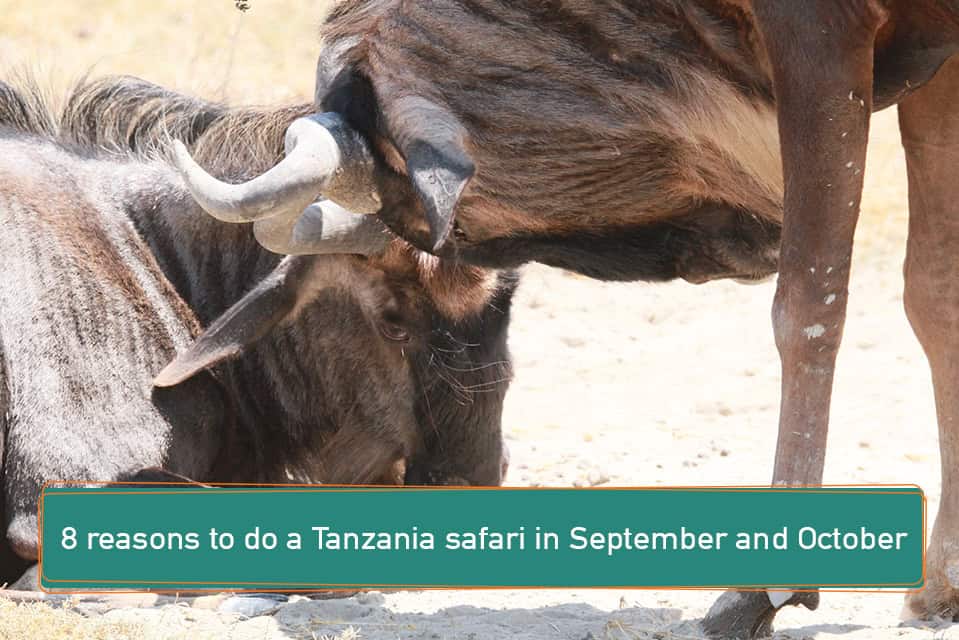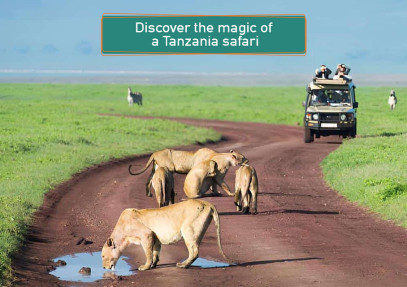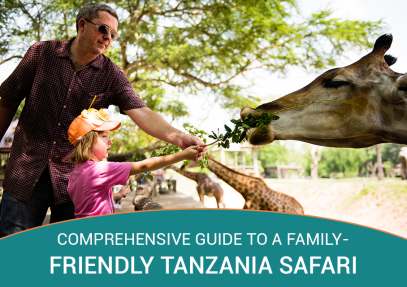
A Tanzania safari in September and October offers some of the best safari experiences in Africa. Whether you’re a seasoned explorer or a first-time adventurer, these months provide unique opportunities to witness nature’s grandeur at its finest. Here’s why you should embark on a Tanzania safari during this magical time of year:
1. Witness the great migration
September and October are pivotal months for the Great Migration, one of the planet’s most remarkable wildlife phenomena. Millions of wildebeests, zebras, and gazelles cross the Mara River from Kenya’s Maasai Mara back into Tanzania’s Serengeti National Park. As these herds venture southward in search of fresh grazing lands, you’ll be at the heart of dramatic river crossings where predators like crocodiles lurk in wait. These months offer high-stakes drama and some of the most heart-pounding action.
Location: Northern Serengeti
Pro tip: Head to Kogatende for prime river-crossing viewpoints.
Map insight: During September and October, the migration is concentrated in the northern Serengeti as herds make their way south. Here’s a snapshot of the movement in these months:
(Include a simple map showing the migration route during September and October from the Maasai Mara to the Serengeti’s northern region.)
2. Ideal wildlife viewing conditions
September and October offer the ideal balance between Tanzania’s dry and wet seasons, with rainfall averaging between 30-60mm across northern Tanzania. The short rains of November haven’t yet begun, which means clear skies and minimal bush growth, making wildlife easier to spot. Temperatures typically range from 25°C to 30°C (77°F to 86°F) during the day, cooling down to 15°C to 18°C (59°F to 64°F) at night, ensuring comfort during your safari.
Water sources shrink during this time, forcing animals to gather around the remaining rivers and waterholes. This concentrated wildlife activity leads to excellent opportunities for sightings of the Big Five—lion, leopard, elephant, buffalo, and rhino.
Best viewing spots: Serengeti, Ngorongoro Crater, Tarangire National Park
3. Fewer crowds, more intimate experiences
With the peak tourism season winding down after August, September and October offer a more serene and intimate safari experience. Camps and lodges often have fewer guests, allowing for more personal attention and unhurried exploration. The savannahs are less crowded, and game drives are quieter, allowing for deeper connections with nature and wildlife. It’s the perfect time to secure exclusive use of camps or join smaller, more tailored safari groups.
Recommendation: Try a mobile tented camp for an authentic, close-to-nature experience with added privacy.
4. Birdwatching paradise
Tanzania is a birdwatcher’s paradise year-round, but September and October are particularly special due to the arrival of migratory birds. Over 1,100 bird species can be found in Tanzania, including flamingos, raptors, and colorful bee-eaters. Many species begin their migratory journeys from Europe, Asia, and beyond, and they arrive during these months to settle near Tanzania’s wetlands, lakes, and rivers.
Top birding locations: Lake Manyara, Ngorongoro Crater, Selous Game Reserve
Bird species to spot: Lesser flamingos, African fish eagles, Malachite kingfishers
5. Picture-perfect photo opportunities
For photographers, September and October offer golden, early morning light, minimal haze, and vast open landscapes that create the perfect backdrop for wildlife photography. Serengeti’s endless plains, the dramatic cliffs of the Ngorongoro Crater, and the vivid red dust of the Tarangire National Park provide striking contrasts that make for breathtaking shots. Plus, with shorter grass and fewer leaves, capturing animals in their natural habitats is far easier during these months.
Photography tip: Bring a long lens (at least 300mm) for those far-off shots and a wide lens to capture Tanzania’s vast landscapes.
6. Mild weather for outdoor comfort
Tanzania’s climate in September and October is particularly pleasant for outdoor activities. With temperatures typically ranging from 25°C to 30°C during the day, it’s neither too hot nor too cold for game drives, walking safaris, or even horseback safaris. The evenings are cool and refreshing, perfect for unwinding by the fire at your camp with a warm blanket and a drink in hand.
Best activity: Walking safaris in the Selous Game Reserve—get up close with nature without the interference of vehicles.
7. Calving season in Southern Serengeti
October marks the beginning of the calving season for many species, including elephants, buffalo, and giraffes. In the southern regions of the Serengeti, such as Ndutu, visitors can witness the birth of new life. Watching young animals take their first steps, guarded fiercely by their mothers, is both exhilarating and heartwarming. Predators also become more active, offering thrilling wildlife interactions.
Game Viewing Tip: Visit the southern plains for incredible sightings of baby animals and predator-prey dynamics.
8. Engage with local culture and communities
September and October present a quieter, more immersive opportunity to engage with Tanzania’s rich cultural heritage. With fewer tourists around, you’ll have more intimate interactions with local communities, including the Maasai and Datoga tribes. Visitors can learn about their ancient traditions, participate in cultural ceremonies, and even spend a night in a traditional Maasai village.
Best cultural experiences: Maasai Mara region, Lake Eyasi for the Hadzabe tribe (hunter-gatherers)
Souvenir: Handcrafted beadwork and Maasai jewelry, known for their striking designs.
By choosing a Tanzania safari in September and October, you’re selecting the perfect mix of natural beauty, wildlife drama, and cultural immersion—without the crowds of the high season. With these eight reasons to visit, it’s clear why this time of year is one of the best to experience Tanzania in its full splendor.
Leave a Reply
Your email address will not be published. Required fields are marked *













No Comments